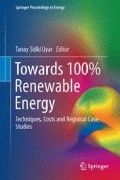Abstract
This chapter presents the methodology and results of the Externalities of Energy project as an example of how the environmental impacts of energy generation can be identified. ExternE was a large international research study sponsored by the European Commission. The ExternE methodology was developed to provide a consistent and transparent framework for transforming all the non-negligible external impacts of energy production into monetary values.
Access this chapter
Tax calculation will be finalised at checkout
Purchases are for personal use only
Notes
- 1.
It should be noted that this does not necessarily imply that wind turbines represent a visual disamenity in all cases; this is dependent on the affected population and their preferences. In order to assess the effect in Turkey a study assessing this would likely be necessary. It is also true that preferences are dynamic, and can change over time.
- 2.
The use of the phrase “statistical life” is intended to emphasise that VOSL is measuring a statistical change in the risk to a life, and not the value of the life of a known individual. While any given individual may value their or another’s life infinitely high, the implicit valuation through their behaviour shows that individuals accept more than zero risk to their life.
- 3.
- 4.
Discounting is the process by which costs or benefits that occur in the future are given less weight than those that occur in the present. This is for a number of reasons, including impatience (or “pure time preference” that individuals prefer benefits now and costs to be deferred), uncertainty regarding the future state of the world, and the opportunity cost of investment (i.e. £1 saved today will return £1 + i in a year’s time where i is the interest rate). The process of discounting generates the present value of a given sum of money:
$$ \mathrm{PV}=\frac{x}{{\left(1+ r\right)}^2} $$Where PV is the present value of the sum of money x, r the discount rate and t the number of years into the future this sum of money is being considered.
References
ExternE (1995) Externalities of energy vol. 2: methodology. Directorate General XII; Science, Research and Development, Brussels
ExternE (2005) Externalities of energy: methodology 2005 update. European Commission, Directorate General for Research, Brussels
ExternE-Pol (2004) Externalities of energy: extension of accounting framework and policy applications. http://www.externe.info/exterpols.html
IER, Germany ARMINES / ENSMP, France PSI, Switzerland Université de Paris I, France University of Bath, United Kingdom VITO, Belgium (2004) New Elements for the Assessment of External Costs from Energy Technologies, Final Report to the European Commission, DG Research, Technological Development and Demonstration (RTD) http://www.ier.uni-stuttgart.de/forschung/projektwebsites/newext/newext_final.pdf
Hammitt J, Graham J (1999) Willingness to pay for health protection: inadequate sensitivity to probability? J Risk Uncertainty 18:33–62
Horowitz JK, McConnell KE (2002) A review of WTA/WTP studies. J Environ Econ Manag 44:426–447
Chilton S, Covey J, Jones-Lee M, Loomes G, Metcalf H (2004) Valuation of health benefits associated with reductions in air pollution. Department of Environment, Food and Rural Affairs, London
Johannesson M, Johansson P (1997) To be, or not to be, that is the question: an empirical study of the WTP for an increased life expectancy at an advanced age. J Risk Uncertainty 13(2):163–174
Tamburlini G (2005) Overview of the risk differences between adults and children, in economic valuation of environmental health risks to children. OECD, Paris
Pearce D, Atkinson G, Mourato S (2006) Cost-benefit analysis and the environment: recent developments. OECD, Paris
DECC 2009, UK Renewable Energy Strategy, https://www.gov.uk/government/uploads/system/uploads/attachment_data/file/228866/7686.pdf
Author information
Authors and Affiliations
Corresponding author
Editor information
Editors and Affiliations
Rights and permissions
Copyright information
© 2017 Springer International Publishing Switzerland
About this paper
Cite this paper
Mistry, R., Simmonds, L.H. (2017). How do The External Costs of Renewable and Fossil Fuel Energy Compare?. In: Uyar, T. (eds) Towards 100% Renewable Energy. Springer Proceedings in Energy. Springer, Cham. https://doi.org/10.1007/978-3-319-45659-1_35
Download citation
DOI: https://doi.org/10.1007/978-3-319-45659-1_35
Published:
Publisher Name: Springer, Cham
Print ISBN: 978-3-319-45658-4
Online ISBN: 978-3-319-45659-1
eBook Packages: EnergyEnergy (R0)

